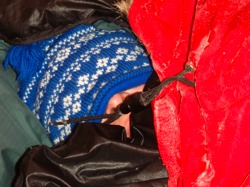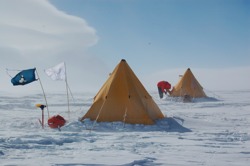GOLF 4-3-9 Antarctica Expedition 2008
Report Day 30 to 37 -- Tuesday 25 November until Tuesday 2 December 2008 -- An Extended High Altitude Acclimatization
GOLF 4-3-9 Antarctica Expedition 2008 |
| Daily Reports 1 | 2 | 3 | 4 | 5 | 8 | 9 | 10 | 13 | 14 | 15 | 16 | 20 | 25 | 27 | 30 | 35 | 37 | 38 | 42 |

We are finally ready to begin our work around the summit of Mount Erebus at elevations between 3200-3800 m. Field work at such elevations always starts, with a mandatory high altitude acclimatization stay of two night at the small camp on Fang Glacier.
The Golf 439 team was accompanied by Nick Giguere, a USAP mountaineer, and we shared the camp with photographer Lisa Blatt (Whiskey 437) and two members of the Golf 081 team, Daria Zandomeneghi and Bob Greschke. It took three helo flights to get us and all of our cargo up to Fang.

Fang Camp had been set up for us by the USAP - BFC team a couple of weeks ago. It is quite sparse with three two-person Scott tents and one toilet tent at one end of the neat row of tents. Hubert set up his own mountain tent, to give him more legroom, even though it has the disadvantage of not being as rugged and built for comfort in a major Antarctic storm. Flags were set up to make sure that nobody got lost in blizzard conditions.
Everything started out according to plan, with a perfect flight on a sunny day, weather conditions that we have begun to take for granted over the last few weeks. A little haziness made the entry into the Fang valley a little difficult for the helicopter and the pilot was a bit worried about contrailing (condensation of humidity in the wake of the helicopter). The contrail can catch up with a helicopter when it lands and dangerously reduce visibility, in particular when landing on snow. When the last helicopter left us at Fang, we found ourselves on an expanse of ice with steep ridges bounding this mountain glacier.

Little did we know that the Antarctic weather was just about going to teach us a lesson about its unpredictability and harshness! We took a little walk around the glacier, built the mountain tent and enjoyed the sunshine. Within 20 minutes the wind picked up and shortened our little exercise walks on the glacier. Within a day the wind speed increased with gusts than must have been at least up to about 75 miles/hour, (air-) temperatures of at least -20 °F, where the wind-chill made it much colder to the exposed skin (should there be any). This whole storm peaked after about three days, but the whole affair took us seven days and six nights, a little more than the anticipated two days required by the USAP: Tent-bound for the most of time, and obviously no helicopter pickup to take us up to Lower Erebus Hut. Later, we heard that this was the first major storm of the season ant that a Scott tent was completely trashed at Cape Crozier. It was lucky no one was in that tent, but they had a hut to move into, we did not.
Hubert spent the first two nights in a small mountain tent but then moved into a Scott tent for the rest of the time. Being tent-bound for that length of time in a forbidding climate offers many challenges, but it is also quite interesting to see how one copes with them. The cold in the tent is a major challenge. If you heat your tent you feel nice and warm, but every bit of snow will turn into water, and everything gets very wet. If you don’t heat your tent (which we did) you have a lesser moisture problem but you have to figure out how to keep most of your face inside the sleeping bag to keep it warm, and you have to watch which way you are breathing, because you exhale a lot of water that eventually will turn the opening of your bag and/or your head-ware into ice and a cold and wet mess. Moisture accumulates as a layer of frost on the inside tent wall, and frosticles that hang down from any irregular surface of the tent wall. Shaking tent walls obviously let some of this ice/snow fall, in particular above the place where all the moisture was generated: your face. The remedy is to sleep on your side, so the frost hits your sleeping bag and not your eyes. Bathroom visits are another story. Pee-brakes are easy. There are pee-bottles and you pour the urine into a bucket where it freezes fast. BM’s are trickier. During the peak of the storm it was almost impossible to make it all the way to the toilet tent, and going to the bathroom inside your tent is not a much better alternative either. The way we adjusted to this was by eating very little so we did not have to go to the toilet tent but drinking enough so we did not get de-hydrated. There is almost nothing one can do except for insulating yourself from the forbidding conditions of this type of storm. You just spent most of your time staying warm, trying to sleep, convince yourself that the Scott tents are build for these type of storms. You definitely do not want to get into your worst fears about your tent ripping apart of being swept by the wind into a horrible snowy mess in some glacier crevasse where nobody would ever find you (should you be alive at that time).
Overall, and certainly in hindsight this episode was not that difficult. Once we got into it, it was a bit like human hibernation. It took some of us some time to realize that the storm was gone after about five days, but eventually everybody emerged from their tents to greet calm winds and sunshine. The helicopter came around lunchtime to pick up three of us, and the other three went up with snow machines. We were ready to open up lower Erebus hut and to begin our work on the mountain.
| GOLF 4-3-9 Antarctica Expedition |